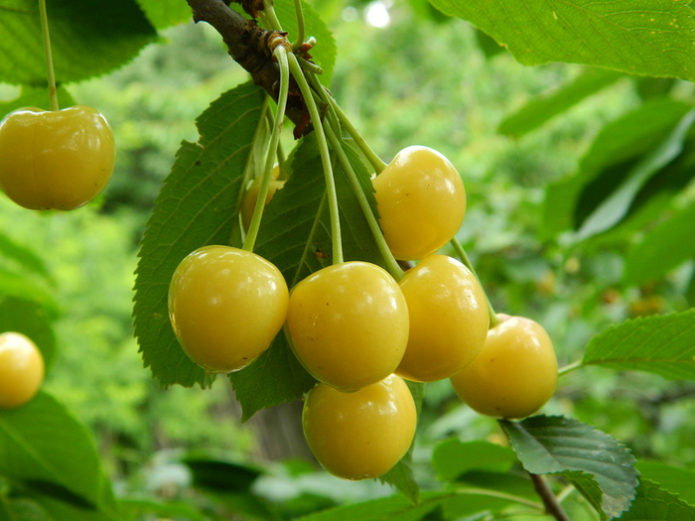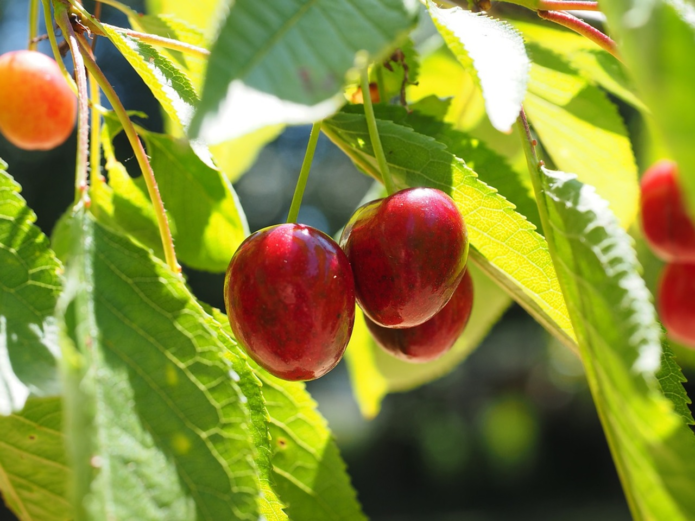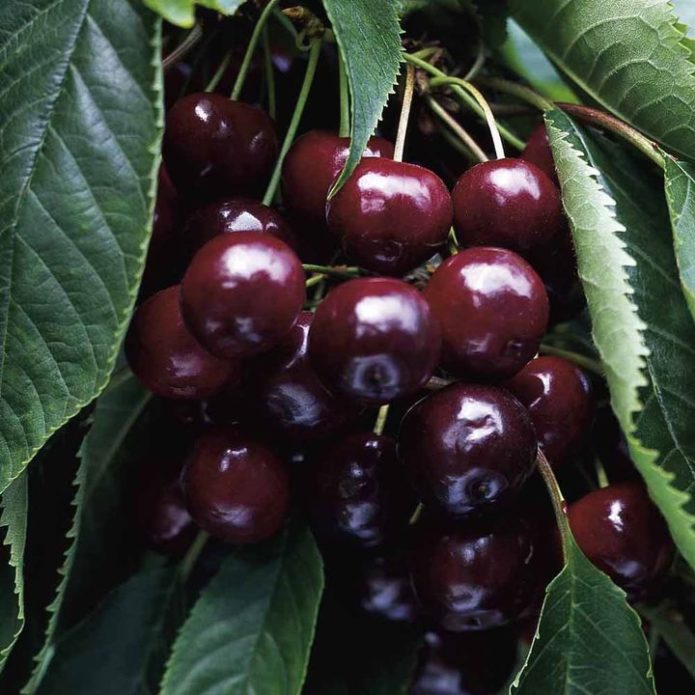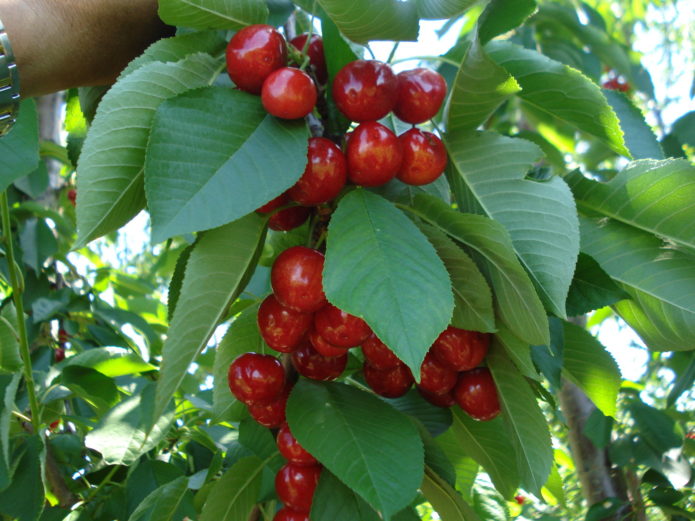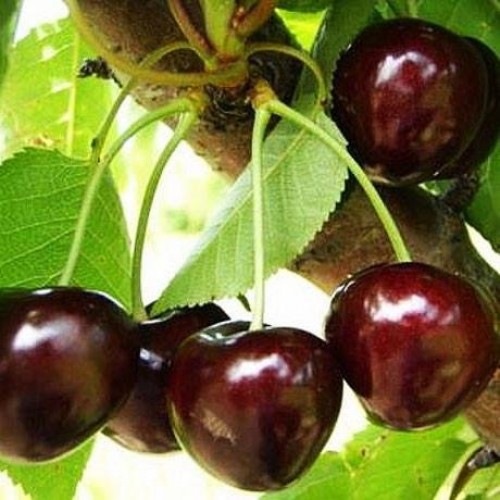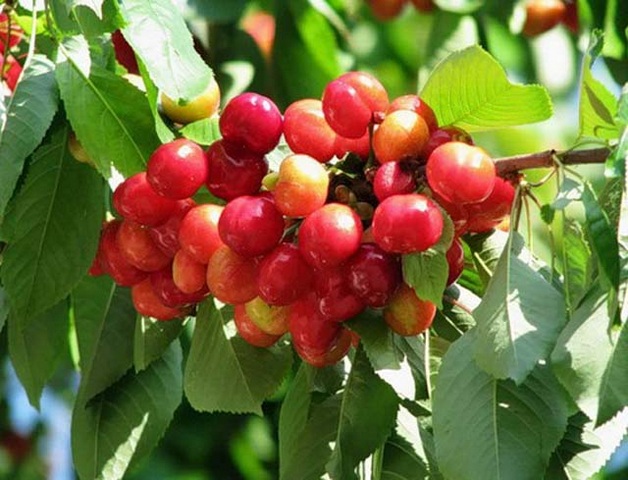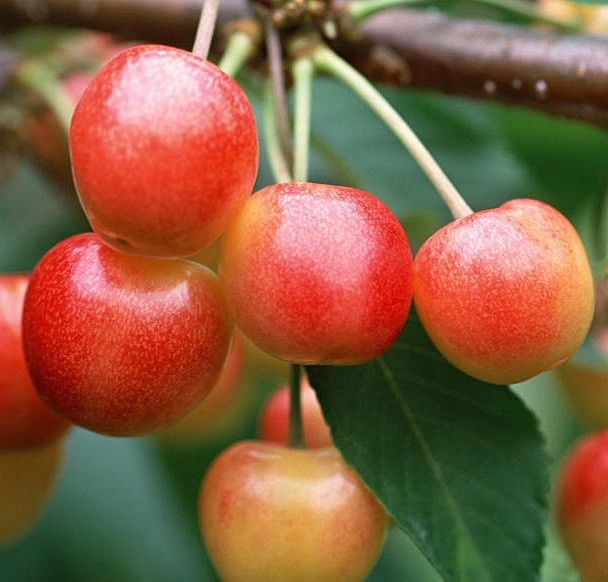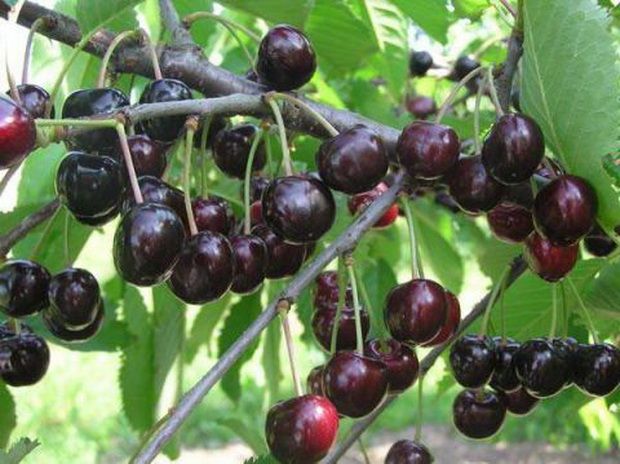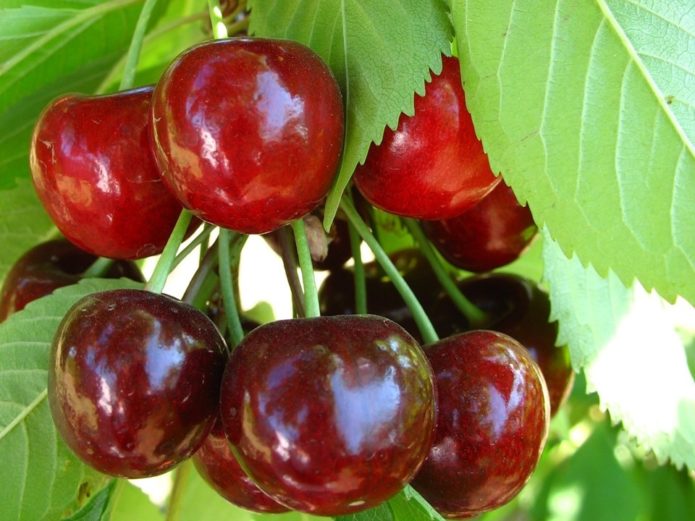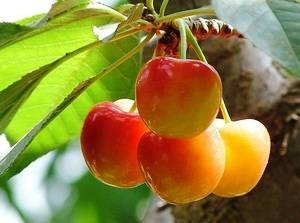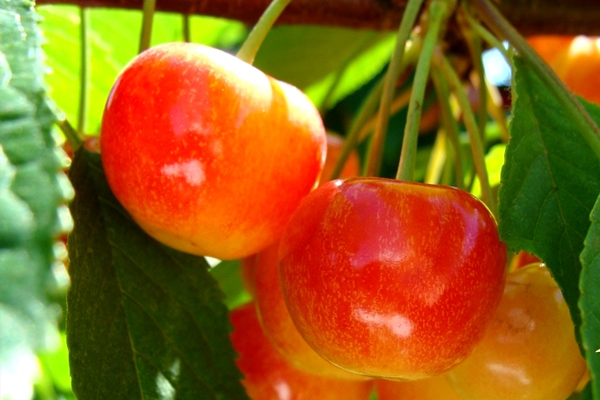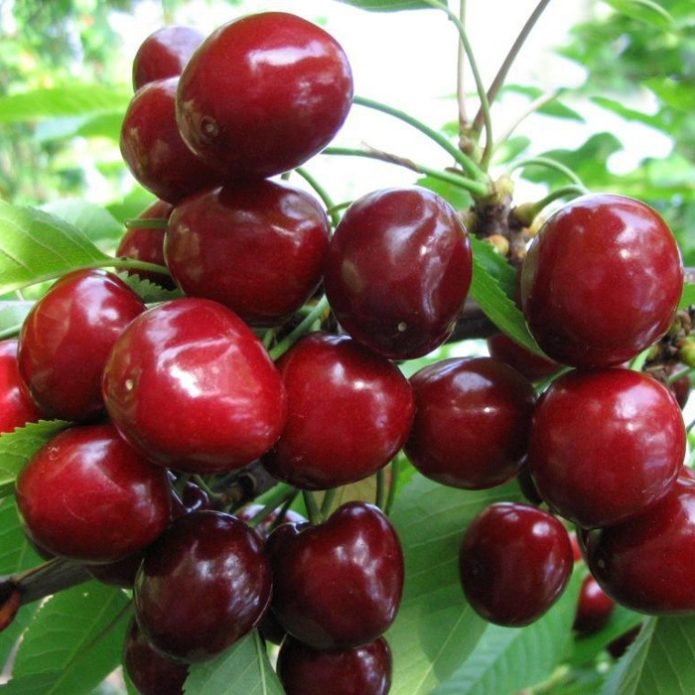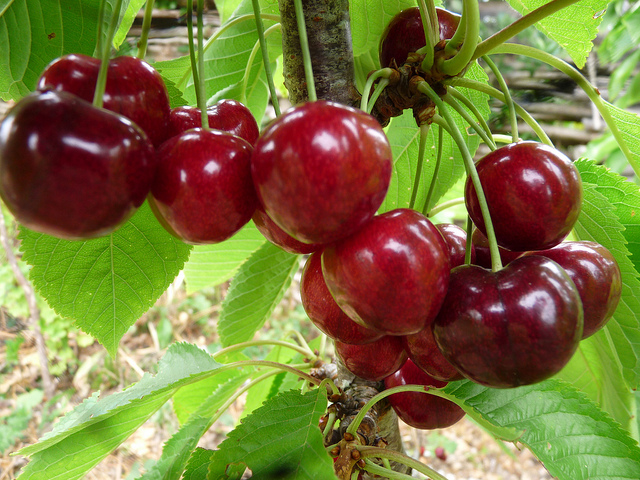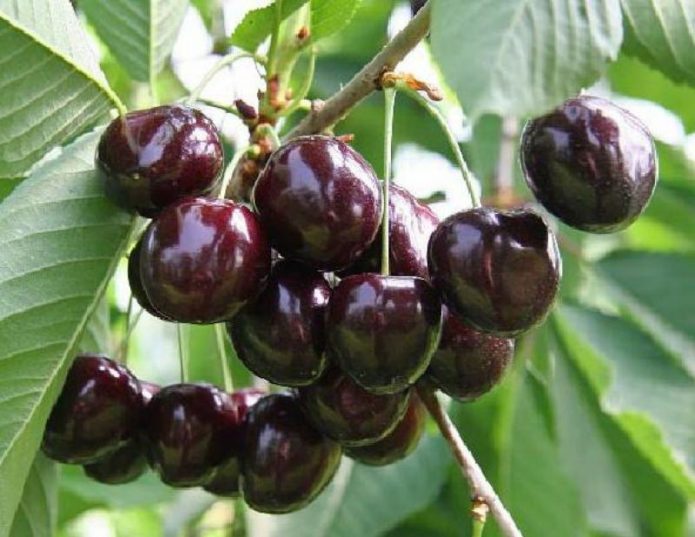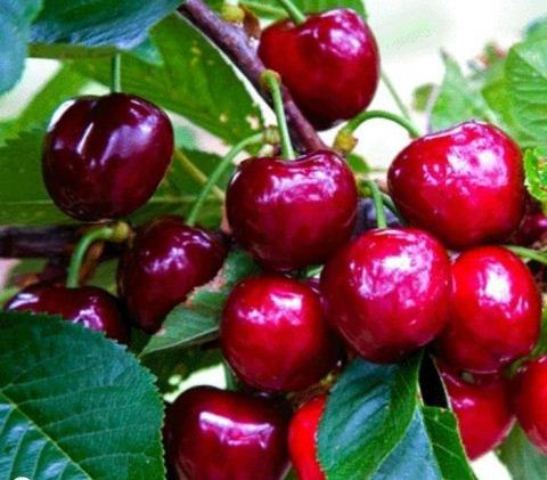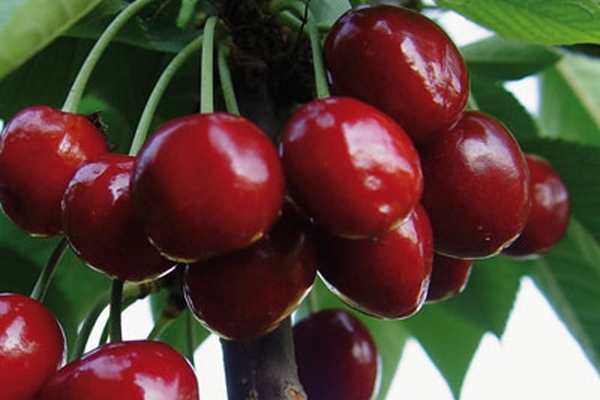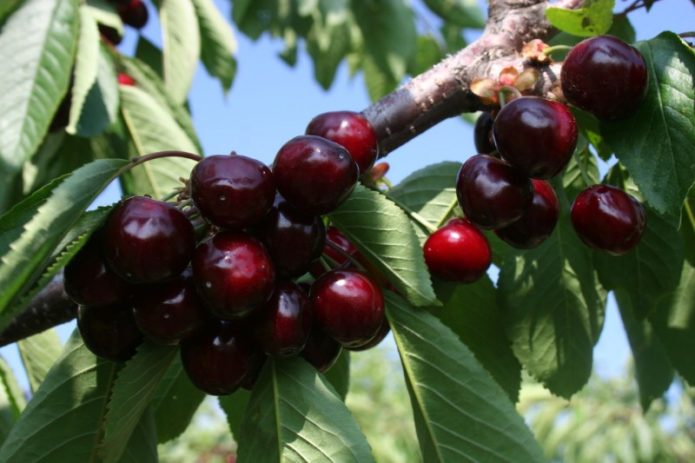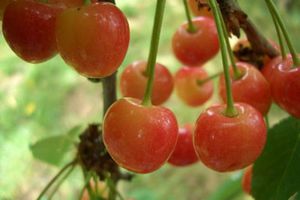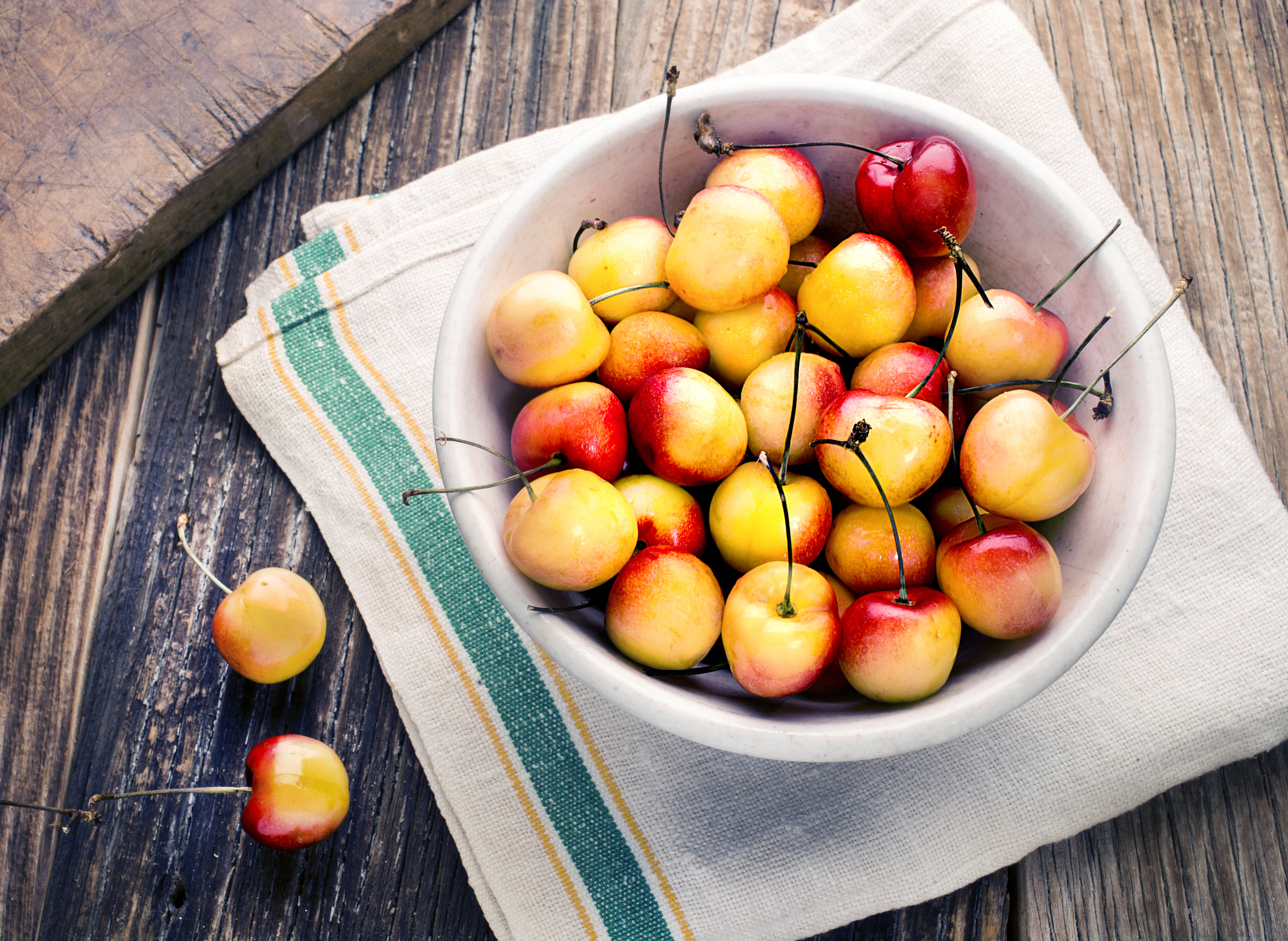There is hardly a person who would not like cherries. Modern breeders develop all new varieties with improved characteristics - more frost-resistant, with genetically "built-in" immunity, and so on. Sweet cherry in the countries of the former USSR can now be grown not only in areas with a warm subtropical climate, but also in regions with relatively short summers and cold winters. The most difficult thing is to make a choice from the available variety. Other things being equal, preference is often given to self-fertile varieties. This allows you to save space in the garden, which is very important for the owners of the notorious "six acres".
Content
For the Northwest region
The climate in the Northwest region of Russia is unpredictable. Summer there, as a rule, is not too hot and sunny, and winter can turn out to be moderately cold and abnormally frosty, moreover, with little snow. For cherries, such conditions are not optimal, therefore the main selection criterion is frost resistance.
Self-fertile varieties of cherries differ from ordinary ones in that they are able to tie a crop without the presence of pollinating trees nearby. Consequently, there is no need to plant several cherries at the same time on the garden plot, because the hope for those that grow with neighbors is not always justified. This allows you to significantly save space, which is always in short supply. Most of the self-fertile varieties appeared relatively recently, therefore, they are characterized by the presence of other advantages, for example, frost resistance, immunity to diseases typical of the culture, high yields, early maturity, and so on.
Backyard yellow
A relatively recent achievement of Russian breeders. The "parents" of the variety are Leningradskaya Krasnaya and Zolotaya Loshitskaya. Household yellow belongs to the category of early varieties. It is recommended by the State Register of the Russian Federation for cultivation in the Black Sea region, but practice shows that this cherry can withstand and successfully adapt to much more severe climatic and weather conditions.
The sapling is distinguished by its growth rate, an adult tree is quite large, with a wide, almost spherical crown. At the same time, it is not very thickened, so caring for the plant and harvesting is not particularly difficult. The tree blooms very beautifully, the flowers are large, snow-white, collected in inflorescences of three.
The berries are medium in size, round, weighing 5–6 g and about 2–2.2 cm in diameter. The lateral seam is not very pronounced. The skin, as you might guess from the name, is bright yellow, smooth. The subcutaneous points are completely absent. The pulp is lighter than the skin, the juice is almost colorless. The taste is sweet and sour, but very balanced.It is rated quite high by professional tasters - 4.7 points out of five. The stone is small, easily separated from the pulp.
The frost resistance of the tree is at -30 ° C. Flower buds rarely suffer from recurrent spring frosts. The first fruiting is expected 5–6 years after the cherry is planted in the ground. Further, the harvests are annual. Even completely ripe berries do not crumble, they rarely crack in damp weather. The backyard yellow is bypassed by such a dangerous pest as a cherry fly.
Video: home garden yellow cherry
Bereket
The sweet cherry variety was bred in Dagestan by crossing the varieties of Drogan yellow and April black. The creators position the variety as self-fertile, but practice shows that it is more likely to speak of partial self-fertility. The State Register of the Russian Federation advises to grow Bereket in the North Caucasus, but with frost resistance up to -30–32 ° C, the variety is quite suitable for the North-West region, other regions with temperate climates. The cold hardiness of flower buds is very high - 95–98%.
Cherry Bereket medium early. When flowering in the last decade of April, it ripens in early or mid-July. The first harvest is tried 4–5 years after the tree is planted.
An adult tree grows up to 5 m or a little more, has a spreading, rather "sloppy" thickened crown. Annual shoots are colored lilac green. The leaves are calyx-like, sagging slightly along the central vein.
The berries are medium in size, weighing 5.5–6.5 g and a little over 2 cm in diameter. The skin is dark scarlet, the flesh is pink-red. In it, veins are clearly distinguished, much lighter. Light acidity does not spoil the taste, which is rated by professional tasters at five points out of five possible. The stone is very small, weighing about 0.5 g. The berries are easily separated from the stalk, so mechanized harvesting is possible. In cool, damp weather, about one fruit in five will crack.
The average yield of Bereket cherries is 20-25 kg per adult tree. The berries are notable for their good transportability. Fresh they can be stored for about a week. A significant drawback is the tendency to defeat moniliosis.
Goryanka
Another achievement of breeders working at the Dagestan experimental station. Goryanka's “parents” are French varieties of cherries Gaucher and Zhaboulet. When flowering at the end of the second decade of April, the harvest ripens in the first half of July.
The height of an adult tree is 3.5–4 m. The crown is densely leafy, in the form of a pyramid with a wide base. Nevertheless, practice shows that you can limit yourself to sanitary pruning. Annual shoots of salad color. The edges of the leaf are smooth, slight "jagging" appears only closer to the tip. Flowers are small, collected in umbrella-shaped inflorescences of 5-7 pieces. The crop ripens exclusively on bouquet branches.
Heart-shaped berries with a rounded base. The side seam is practically absent. The average weight of one cherry is 6–6.5 g. The skin is wine-burgundy, the pulp is intensely scarlet, the juice is of the same color. The taste is excellent, has earned a professional rating of 4.9 points out of five. Berries do not differ in transportability; fresh they can be stored for 5-6 days. Average yield is 18-22 kg per tree. The berries ripen at the same time. The first fruits will have to wait 4–5 years.
Frost resistance of Horny Goat weed is at the level of -28–30 ° C, of flower buds - about 90%. Even opened flowers rarely suffer from recurrent frosts. The variety tolerates short-term drought well, but with a prolonged moisture deficit, the tree practically stops growing, the shoots dry out and die off.
Dunn
One of the latest achievements of Russian breeders.The "parents" of the variety are the same as those of Priusadebnaya yellow, but the result of crossing is completely different, although Danna also belongs to the category of early varieties. It entered the State Register in 1999 after zoning in the North Caucasus.
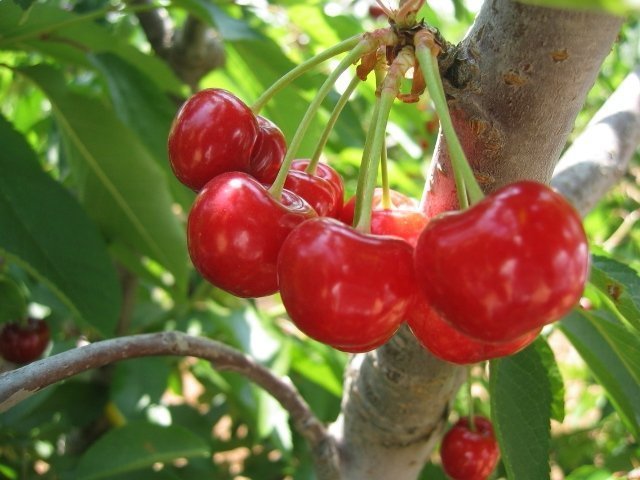
Danna is a promising Russian cherry variety; it is also interesting for those who grow berries on an industrial scale.
The tree is of medium height, about 4 m. The crown is in the form of a pyramid, quite rare. Shoots are reddish brown. Leaves of a light lettuce shade, rather narrow and elongated for cherries. The buds are collected in inflorescences strictly in three.
The berries are medium-sized, weighing 4.5–5.5 g and 1.6–1.8 cm in diameter, but very sweet. The taste has earned a rating of 4.7 points out of five from experts. The peel is rich scarlet, monochromatic, smooth. The fruits are distinguished by a high content of vitamin C - more than 10 mg per 100 g. The lateral "seam" is poorly expressed.
Danna is characterized by resistance to adverse weather conditions - cold (up to -35 ° C), heat, drought. This sweet cherry rarely suffers from diseases typical of the culture, and is rarely affected by pests. For almost two decades of cultivation, no significant shortcomings have been found. Those who grow fruits and berries on an industrial scale are showing an increased interest in the variety. The first fruits will have to wait 5–6 years.
Pridonskaya
Another Russian sweet cherry variety, bred at the I.V. Michurin Research Institute as a result of crossing the Zolotaya Loshitskaya and Early Mark varieties. The fruits ripen at the beginning of the second decade of July. Pridonskaya is considered self-fertile, but practice shows that planting nearby varieties Revna, Iput has a positive effect on yield.
The tree is not tall (up to 3.5 m), the growth rate does not differ. Crohn is quite rare. Shoots are dark red, with an almost imperceptible brownish undertone, covered with well-distinguishable whitish "lenticels". The buds are collected in inflorescences of three. More than 90% of the crop ripens on bouquet branches.
The average weight of a berry is 5-6 g. They are one-dimensional, as if calibrated. They are easily separated from the stalks. The skin is blood-scarlet, the flesh is pink-red (artists call this color scarlet), very juicy. Light "cartilages" are well distinguishable. The taste is sour-sweet, refreshing.
Pridonskaya has a high immunity against diseases typical for the culture, it is bypassed by most pests. The tree suffers little from heat and moisture deficit, in winter it tolerates frosts down to -25-28ºС without much damage to itself. Flower buds are resistant to recurrent spring frosts.
The first harvest has to wait 6–7 years, then annual fruiting. Average yields are 20-25 kg per mature tree. The plant does not need formative pruning, it is quite enough sanitary. The variety is quite suitable for growing on an industrial scale. There are no significant shortcomings in the Pridonskaya cherry. Since 1999, when the culture was included in the State Register of the Russian Federation, it was not possible to identify them.
Valery Chkalov
One of the oldest well-deserved varieties, which has not lost its popularity to this day. This is a "natural" hybrid, obtained as a result of spontaneous pollination of the Caucasian pink cherry. State trials began in the mid-50s of the last century, in 1974 the variety was recommended for cultivation in the North Caucasus, from where it gradually spread to territories with a temperate climate.
The tree grows to 5.5–6 m in height and has a rather dense pyramid-shaped crown. With age, it seems to "squat", the crown becomes more spreading. Shoots are grayish-brown, powerful. They very often bend under their own weight or under the weight of the crop. The bark is rough to the touch. Leaves are ovoid, sharply tapering to the tip.Flowering occurs in early April, fruiting - in the first decade of July.
The berries are large, weighing 6–8 g, in the form of an almost regular ball or heart with smoothed outlines. The skin is very dark red; from a distance the cherry looks black. The juice is rich scarlet. The stone is rather large, it is not too readily separated from the pulp. The taste is sour, but very pleasant. The content of vitamin C is almost a record - 21.5 mg per 100 g.
Fruiting begins five years after planting in the ground. The harvest ripens annually. From an adult tree, depending on the region of cultivation, you can remove from 60 to 150 kg of berries. Frost resistance up to -25ºС. A significant disadvantage is the tendency to attack by pathogenic fungi, especially those that cause gray rot and coccomycosis. Nevertheless, the tree is very hardy, capable of recovering even from serious damage.
The variety is considered partially self-fertile, the presence of cherries nearby Early Mark, Bigarro Burlat, Zhabule, Aprilka, Skorospelka helps to increase yields. Valery Chkalov is one of the most popular types of cherries for breeders' experiments. With his participation, varieties Valeria, Annushka, Farewell, Donetsk beauty and many others were bred.
Cherry variety Valery Chkalov
For Belarus
The climate of Belarus is in many ways similar to that characteristic of central Russia. Accordingly, varieties suitable for the North-West region can be successfully grown on the territory of this republic. Other, less frost-resistant Russian varieties of cherries are willingly planted there. Belarusian breeders also have their own achievements that are popular with fellow citizens.
Beauty
Sometimes it is called Etok beauty. The variety has a consistently high yield. Bred in the Stavropol region by crossing the Denissen yellow and Dyber Black varieties. An essential advantage is absolute resistance to coccomycosis.
The variety is partially self-fertile. To increase the yield, the cherries of Daiber, Golubushka, Franz Joseph, Narodnaya are planted nearby. Because of the late flowering, the Beauty almost never falls under returnable spring frosts.
The tree reaches a height of 3.5–4 m, the growth rate does not differ. The crown is spreading, pyramidal or almost spherical. There are relatively few shoots, they are located in relation to the trunk at an angle of approximately 50º. The surface of the leaf is slightly wrinkled. Most of the crop ripens on bouquet branches at the age of 2–5 years.
The average weight of a heart-shaped berry is 8-9 g. Fruits are slightly flattened. The seam is practically invisible. The skin is bright yellow with a golden tint. The pulp is yellowish, very juicy and sweet. The juice is almost colorless. The stone is not large, it is separated from the pulp without effort. The crop ripens in the first decade of July. The fruit is characterized by very good transportability.
The variety is fast-growing, the tree bears fruit for the first time 3-4 years after planting in the ground. About 40 kg of berries are removed from plants under the age of 10, and by the age of 15 this figure doubles.
Ovstuzhenka
The variety was bred in 2001 by one of the most famous breeders in this area - M.V. Kanshina. In Russia, the State Register is recommended for cultivation in the Central Region. Ovstuzhenka is considered self-fertile, but the presence of pollinating varieties is still recommended - Revna, Tyutchevka, Pink Pearl, Bryansk Pink.
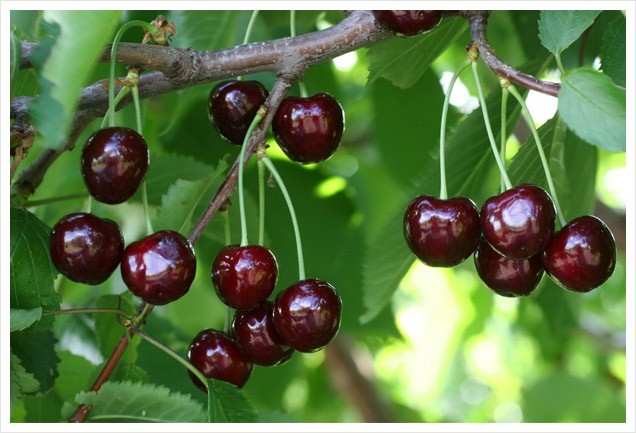
Winter hardiness of cherries of the Ovstuzhenka variety allows it to be grown in regions with any climate, with the exception of the subarctic
The tree is distinguished by its growth rate, so it reaches its “ceiling” of 3–3.5 m by the fourth year of life. After the first fruiting, it grows mainly in width. His crown is not too thickened, almost spherical. The flowers are large, collected in inflorescences of three. Snow-white petals are overlapped.Flowering occurs in early April.
Most of the fruits weigh 4–4.5 g, but there are also “champions” weighing 7–7.5 g. The berries are round or slightly elongated. The skin is very dark with a purple tint. From a distance, the berries appear almost black. The pulp is not too firm, but very juicy, bright red. The stone is small, easily separated from it. Sweet and sour taste is rated 4.5 out of five.
The berries ripen in late June or early July. The first fruiting will have to wait 4–5 years. Young trees bring 15–20 kg of berries, then the yield increases to 30–35 kg.
Ostuzhenka has a very high frost resistance of wood (up to -45 ° C), and somewhat less - of flower buds. Also, the first almost never gets sunburn in winter. Up to 15% of buds can suffer from return frosts in spring. She never suffers from moniliosis and coccomycosis, but can become infected with clotterosporia.
Narodnaya Subarova
The main distinguishing feature of this Belarusian variety is a very powerful tree. It grows up to 5-6 m in height, the crown is extremely wide. Accordingly, she is not afraid of any, even the strongest, winds; branches rarely break under the weight of snow. Also, the variety is valued for its undemanding quality of the substrate.
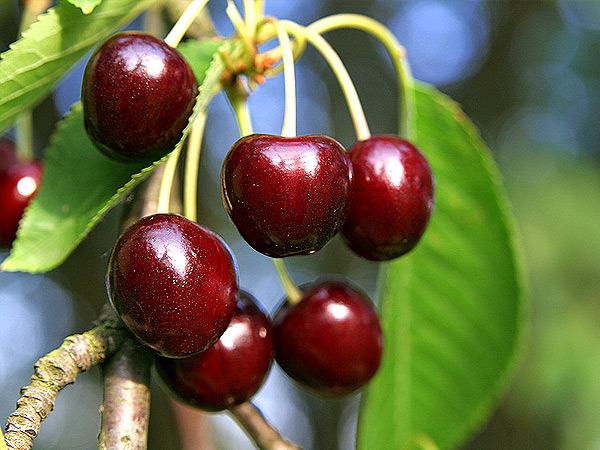
Cherry variety Narodnaya Syubarova is distinguished by its general unpretentiousness and undemanding to the quality of the substrate
The fruits are dark scarlet, the skin is glossy. The average weight of a berry is 5.5–6 g. Productivity is at the level of 50–55 kg per mature tree. The first fruits are removed 4 years after the tree is planted in the garden. Cherry ripens en masse, in the middle of the second decade of July. Fruiting is annual.
The variety has an "innate" immunity to coccomycosis, rarely suffers from other fungal diseases. Self-pollination at the level of 90%.
Gastinets
Sometimes the spelling "Gastsinets" is found. One of the most popular Belarusian varieties. "Parents" - Red dense and Aelita. Belongs to the category of medium early (ripens in mid-July) and partially self-fertile. To increase yields, you can plant Narodnaya, Zhurba nearby.
Winter hardiness at -25 ° C. The tree bears fruit annually. The variety has an "innate" immunity to coccomycosis. Differs in early maturity. The first berries are tasted already three years after planting.
The fruits are large, heart-shaped, weighing about 7 g. The skin is bright yellow, the blush where the sun hits it is crimson or raspberry. The pulp and juice are almost the same color as the skin.
Tyutchevka
A popular Russian late cherry variety, bred at the beginning of the 21st century on the basis of the Red dense variety and a hybrid with the code name 3–36. In the Russian Federation, the State Register is recommended for cultivation in the Central region, respectively, and for Belarus it is quite suitable. Due to partial self-fertility, it is recommended to plant pollinators (Revna, Iput, Raditsa).
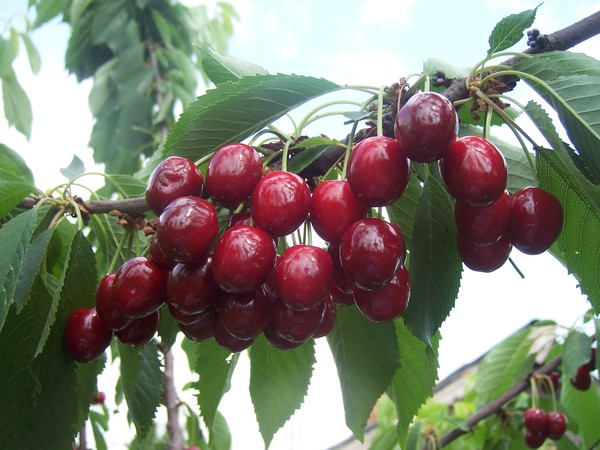
Cherry Tyutchevka is not devoid of significant flaws, but this does not affect its popularity in any way
The tree is relatively low, up to 4 m. It reaches its maximum size already 4–5 years after planting. The crown is in the form of a ball, sparse. Leaves with very short petioles. The buds are collected in inflorescences of four. Approximately 85% of the fruits ripen on bouquet branches.
Berries weighing 5-7.5 g, dark scarlet with lighter subcutaneous dots. The stone is small, it is reluctantly separated from the pulp. The fruits are sweet, but "cartilage" is clearly felt in the pulp. However, the taste is rated 4.9 out of five. The crop ripens in the first decade of August. 18-25 kg of berries are removed from a mature tree. The first fruiting is five years after planting.
Among the disadvantages of the variety are berries that crack in rainy summers and the low winter hardiness of flower buds. More than 70% of future buds can suffer from return frost. There is also a tendency to defeat coccomycosis and clasterosporium.
In memory of Astakhov
Another late cherry variety that ripens closer to mid-August. The tree is 4–4.5 m high, with a rounded, not too dense crown. Differs in growth rate. The bark is grayish, highly flaky; after the leaves fall off, it becomes silvery.
The fruits are very presentable - one-dimensional, large (8 g and more). Deep burgundy berries. The stone is small, it separates well from the pulp. The skin is thin, smooth. The berry flavor is rated 4.8 out of five. Average yield is about 30 kg per tree.
The variety is rarely affected by diseases typical for the culture, its winter hardiness is at the level of -25-28 ° C. The berries ripen 5–6 years after the seedling is planted.
For Ukraine
The climate in most of the territory of Ukraine is much milder than in Russia and Belarus. Accordingly, local gardeners can afford to choose a cherry variety, focusing not only on winter hardiness, but also on the size, taste of the fruit, and yield. Recently, varieties from Europe and North America, which are grown in their homeland on an industrial scale, are gaining more and more popularity.
Annushka
A popular Ukrainian variety obtained with the participation of Donchanka cherries and Valery Chkalov. In Russia, he also received recognition, in 2000 he entered the State Register. It is recommended for cultivation only in the North Caucasus and the Black Sea region, but its high (-32–35 ° C) winter hardiness allows it to be grown in temperate climates.
The tree is of medium height, 4–4.5 m. The crown is not particularly thickened. The shoots are thick. The buds are collected in inflorescences of 3-4 pieces. Flowers open before leaves appear.
Annushka is distinguished by presentability and large (9–10 g) berries. The skin is rich scarlet. The pulp is slightly lighter, very sweet and juicy. Moreover, it is quite dense, which provides good transportability. Fruits are round, slightly flattened towards the base. Average yield is 20–22 kg.
The taste of the berries is little influenced by the way summer turns out. Annushka rarely suffers from drought, disease (with the exception of coccomycosis) and pests. The tree brings its first harvest in 3-4 years. For 10-12 years of fruiting, there is one "rest" season. This variety of cherries requires careful site selection, being particularly sensitive to excessive soil moisture due to groundwater close to it. The tree grows quickly, so it needs regular pruning.
Tenderness
An old well-deserved variety, bred in the 60s of the last century in Kiev on the basis of Drogan yellow and Francis cherries. Differs in winter hardiness up to -30 ° C, belongs to the category of mid-season. The harvest ripens in the last days of June. Because of this, it is not affected by the cherry fly - adults simply do not have time to lay eggs. The tree is up to 3 m high, the crown seems to be flattened, in the form of a wide oval.
The fruits are very presentable - golden-yellow with a bright crimson blush, one-dimensional, weighing 6.5–7 g. But you need to remove them from the tree very carefully - even from the lightest pressing on the skin, ugly brown spots blur. The "seam" is clearly visible. The pulp is pale yellow, its taste is pleasant, sweet and sour. Tasting score - 4.7 points out of five.
The first time Tenderness bears fruit 6 years after planting. 50-60 kg of berries are removed from an adult plant. Moreover, the more fruits, the smaller they are. To increase the yield (although the variety is formally self-fertile), Drogana, Nectarnaya, Kitaevskaya black are planted next to Tenderness.
Video: what cherry Tenderness looks like
Backyard
One of the earliest sweet cherry varieties. The fruits ripen in the first decade of June. The berries are one-dimensional, the skin is pale yellow with a vague pinkish "blush". The pulp is light, creamy. The yield is extremely high (80 kg and more). Some amateur gardeners even consider this a disadvantage. Fresh fruits are stored for a very short time and do not differ in transportability. Accordingly, you need to eat or process berries in record time. Taste qualities are highly rated - by 4.8 points out of five possible.
The fruits do not crack, even if heavy rains fall during their ripening. The first time a sweet cherry ripens 3-5 years after planting a seedling. The tree is of medium height (3.5–4.5 m), the crown is rather rare, but spreading. The average berry weight is 5-6 g.
Planting cherries nearby Valery Chkalov, Skorospelki, Bigarro Burlat helps to increase the yield of a partially self-fertile variety. Frost resistance is quite sufficient for growing in most of the territory of Ukraine. The tree is rarely affected by moniliosis, coccomycosis, "black cancer". Due to the early maturity, the cherry fly does not have time to lay eggs in the fruit ovaries.
Valeria
One of the most successful of the many varieties bred with the participation of cherries Valery Chkalov. His homeland is Ukraine, where he is grown everywhere. Valeria is distinguished by its large-fruited and excellent berry taste. Another significant plus is resistance to damage by pathogenic fungi and pest attacks. The variety is partially self-fertile.
The tree is vigorous, the crown is rather dense, almost spherical. Valeria blooms late, therefore it is guaranteed not to fall under return spring frosts, although in most of Ukraine this is a rather rare phenomenon.
The average weight of a heart-shaped berry is 9–10 g. The skin is dark-burgundy, the flesh is slightly lighter. The pulp is soft, not very dense, juicy. To increase productivity, it is desirable to have pollinators - Donchanka, Annushka, Lesya, Ugolyok. Ethics is categorically not suitable in this capacity. Fruiting is annual, an adult tree bears 30-50 kg of berries.
Lapins
Canadian cherry, bred on the basis of the popular varieties of Van and Stella. Belongs to the category of late, the harvest ripens in the last decade of July or early August. Lapins is a completely self-fertile variety, practice shows that in the absence of pollinators, the same number of berries are tied as in the presence of them.
The fruits are very large, weighing 10 g or more. The shape is round or oval, slightly flattened at the stalk. The skin is colored red, sometimes with a noticeable orange undertone, the flesh is pink-scarlet, dense. The palatability is excellent, estimated at 4.8 points.
The variety does not differ in frost resistance, it also suffers from prolonged droughts. If the summer is rainy, it is more than likely the development of rot and moniliosis, cracking of the berries. There is "innate" immunity from clasterosporia and coccomycosis.
The tree is tall, but it forms new shoots rather reluctantly. Crown formation will require considerable effort from the gardener. You can make your task a little easier by grafting Lapins onto a dwarf stock.
Even perfectly ripe berries do not fall from the tree. The variety is distinguished by good transportability; cherries can be stored in a refrigerator or similar conditions for up to two weeks.
Dolores
The variety is of medium ripening, fruits are harvested in the second decade of June. Bred in Dagestan. “Parents” are Napoleon black cherry and Lyubskaya cherry. The height of the tree is about 3.5 m, the crown is spreading, dense. But it does not need formative pruning, it is quite sanitary.
Berries are medium in size (weighing about 6 g), round in shape with pronounced "shoulders" and side seam. The skin is rather thin, purple-violet, almost black with dark scarlet spots.The pulp is bright red, juicy, literally melts in your mouth. The taste has earned the highest possible assessment from the tasters.
Wood and flower buds have good frost resistance. Dolores is not particularly affected by droughts. The exception is very intense heat, which, in the absence of rain, can provoke a delay in tree growth and the death of individual shoots. Immunity to fungal diseases is high, with the exception of coccomycosis.
The first fruiting will have to wait 4–5 years. Average yield is 24–32 kg. If there are nearby cherries Iput, Revna, this indicator increases. Fresh cherries can be stored for 5-7 days.
Sweetheart
Canadian late cherry variety. In North America, one of the most popular for industrial cultivation. Differs in good drought and frost resistance, high transportability. The fruits are harvested at the very end of July or in the first decade of August. A tree of medium height, with a spreading crown. Among the shortcomings, one can note a weak immunity to fungal diseases typical of the culture.
The berries are large, weighing 10–13 g, heart-shaped, but noticeably elongated vertically. The skin is blood-red. The pulp is very sweet, juicy, so tough that it almost crunches. The fruits do not crack even in very rainy weather. Productivity - more than 60 kg per tree.
Bigarro Burlat
An early French sweet cherry variety known since the beginning of the last century. Considered the result of natural selection, "parents" have not been established. The tree is 3–3.5 m high, the crown is in the form of an almost regular ball, thickened. Brownish shoots are dotted with often spaced whitish "lenticels".
Fruits are medium-sized, weighing 5–6.5 g, slightly flattened in shape. The lateral "seam" is clearly visible. The skin is almost black, the flesh is dark scarlet. The stone is rather large and can be easily separated from it. The berries are tried for the first time 4–5 years after the tree has been planted. In the future, the average yield is 75–80 kg.
Winter hardiness at the level of -20 ° C, this applies to both wood and flower buds. Immunity to pathogenic fungi is good, but it can be better. In cool rainy weather, the fruit tends to crack. The variety is partially self-fertile, in order to increase yields, Exhibition, Napoleon black, Bigarro Starking are planted nearby.
Staccato
Late self-fertile variety of Canadian selection. It ripens in the second decade of August, one of the very last. Natural mutation resulting from free pollination of Sweetheart cherries.
The berries are large, maroon, weighing 11–12 g, slightly flattened in shape. The skin is firm but thin. The pulp is juicy, very sweet. The taste is rated 4.8 out of five. The first time a tree bears fruit is 3-4 years after planting.
Winter hardiness at -25 ° C. The variety is distinguished by undemanding care, the ability to adapt to a wide range of not always favorable climatic and weather conditions, and good immunity.
Thanks to the achievements of modern breeding, sweet cherries are now successfully cultivated in areas with a temperate climate, and the berries are not much inferior in taste to the southern ones. Self-fertile varieties have a number of significant advantages compared to other varieties. Of course, most of them are not without individual flaws, but most often they do not spoil the overall picture.
